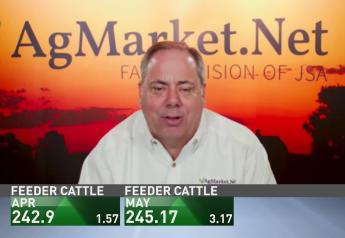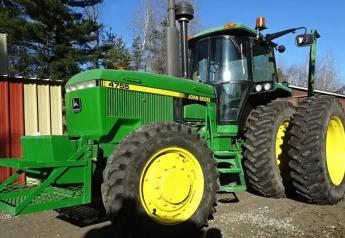Running Out of Time: Prevent Plant Decisions Mount in Northern Corn Belt
USFR-FJR Slow Planting 5/14/22
After the slowest start to planting since 2013, farmers across much of the Midwest finally found a window to plant last week. However, farmers in the northern Corn Belt are still struggling to get this year's crop in the ground, and it's now a race against the calendar.
“I think [last year] the first couple days of May we were wrapping up other than a few wet spots, this year we’re just going to be getting started,” Chad Schooley, a farmer in Castlewood, South Dakota told Michelle Rook of Farm Journal.
Farmers in southern South Dakota saw a slight warm-up in temperatures, as well as pockets of dry weather. The combination was enough to finally push the 2022 planting season into action for some parts of the state, but other portions of South Dakota were still in waiting mode.
“Soil temps are in the low 30s and not a lot of sunny days and forecast has more rain in it,” says Todd Hanten, farmer, Goodwin, South Dakota. “So, not a lot going on at all around here.”
While the wet and cooler weather has plagued much of South Dakota this year, Thursday, severe weather struck as a derecho hit the state. Video from South Dakota shows the hurricane-force winds that hit South Dakota and Minnesota with winds clocking in between 70 mph and 107 mph in some areas.
Producers across the area suffered a heavy amount of damage including roofs ripped off barns and grain bins crushed at what is typically a busy time of year with planting season.
Planting Progress Doubles
Two weeks ago, just as the weather turned more favorable for planting, USDA showed 22% of the corn crop had been planted, the slowest start since 2013. However, farmers made great strides in a week, with the latest USDA Crop Progress Report indicating 49% of the corn crop is now in the ground, a 27 point jump in just a week.
While planting progressed more in a week than it had the entire planting season so far, progress is still 18 percentage points behind the five-year average and 45 points slower than last year’s historic corn planting pace.
Farmers in Iowa and Illinois were extremely behind planting just a couple weeks ago, but as of this week, USDA says Illinois farmers jumped from only 15% planted to now 55% complete. Iowa farmers propelled the planting pace from 14% last week to now 57% planted.
Northern Corn Belt Planting Struggles
North Dakota, Minnesota, South Dakota and Iowa are the most behind in planting versus each state’s average pace. USDA says as of Sunday, North Dakota farmers had only planted 4% of the state's corn crop, 37 points. behind average.
“When you start to lay out North Dakota in parts of northern South Dakota, into the Red River Valley through like Breckenridge, Fergus Falls that area, it's been very limited. It's struggling,” says Kristi Van Ahn-Kjeseth, COO of Van Ahn and Company, Inc.
Historically high commodity prices mean North Dakota farmers are doing everything they can to plant the crop, but more rain recently served as another reminder Mother Nature is ultimately in control.
“I think producers really want to wait it out, and I think that's the biggest struggle right now is that even when you crunch any other realistic number, they are profitable, but not as profitable as corn,” says Van Ahn-Kjeseth
Running Out of Time to Plant
The cutoff date to plant corn in most of North Dakota is around May 25, which is only a week away. Farmers have more time to plant soybeans, as the crop insurance deadline is around June 10th.
“I think they really want to get that corn in the ground. It's just if you get this rain system that comes through, I'm not so sure after 2019 producers are really going to want to push that after they had to deal with the test weight issues, the drying issues that they had to deal with after putting corn in the ground in June,” says Van Ahn-Kjeseth
DuWayne Bosse, of Bolt Marketing, also farms. He says his area of northern South Dakota is ver similar to North Dakota with little to no planting taking place, and once it does dry out, field work still needs to be done.
“We haven't even done the tillage work to prep the ground yet for planting,” says Bosse. “From about highway 212 north in South Dakota and all the way through North Dakota, it's very similar and very little planting progress has been done.”
Bosse says he doesn’t think all the forecast corn acres in South Dakota and North Dakota will get planted, just due to extremely wet field conditions with even more rain on the way.
“When you look at the S&D tables right now, you start to take 1 to 3 million acres off of corn or soybeans, it gets very tight,” he says. “We're supposed to plant 3.5 million acres of corn in North Dakota, I think there could be 1 million acres taken off there due to 1 million acres of prevent plant corn.
Prevent Plant Acres Could Grow
Bosse says while producers have every incentive to plant, the weather is making it impossible to get in the field. He thinks the loss of acres won’t be a story that fully hits the market until more than a month from now.
“Probably mid to late June,” says Bosse. “Right now, USDA is forecasting about 2 million acres of prevent plant, which would be close to last year's number. The average is around 4.5 million. And right now, as wet as we are, we're looking wetter than normal. So mid-June that should really start to hit the market when we talk about it.”
The Yield Debate
The impact on acreage is also spurring debate on the impact on final yields.
“We've taken a record yield off the table,” says Dan Basse of AgResource Company.
While the yield debate is already stirring mixed reaction, farmers who were able to plant in South Dakota last week remain optimistic about yields.
“I’m fully expecting my yields, provided we don’t have a drought this summer to be just fine,” says Tim Ostrem, a farmer in Centerville, South Dakota told Farm Journal’s Michelle Rooke.
However, other farmers in South Dakota aren’t so sure, saying if the weather cards don’t fall in his favor soon, production will suffer.
“We’re getting to where yields may start to get reduced because of late planting and always the earlier we get it in the better crop we generally have,” Hanten says.
Related Stories:
Surprising Cut to Corn Yields and North Dakota's Planting Nightmare Show Crop Supplies are Shrinking
Planters Pick Up Pace, But Corn Still 18% and Soybeans 9% Behind Average







